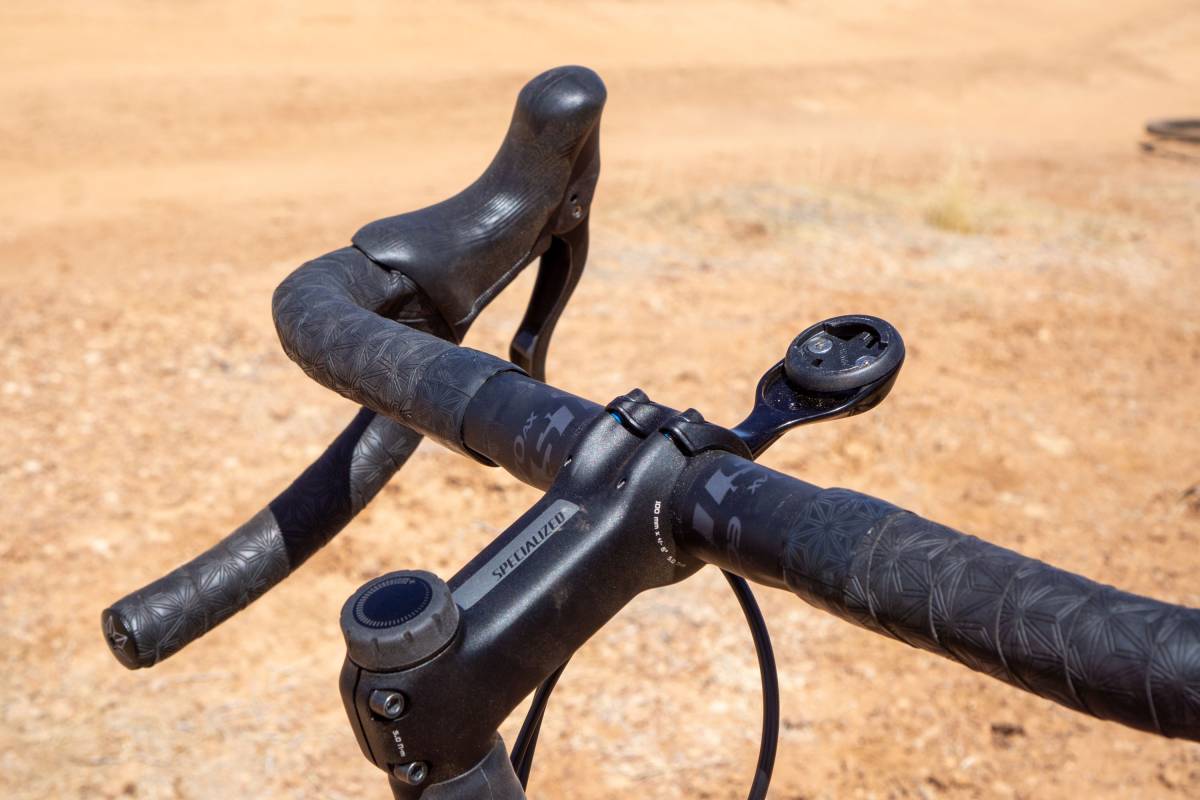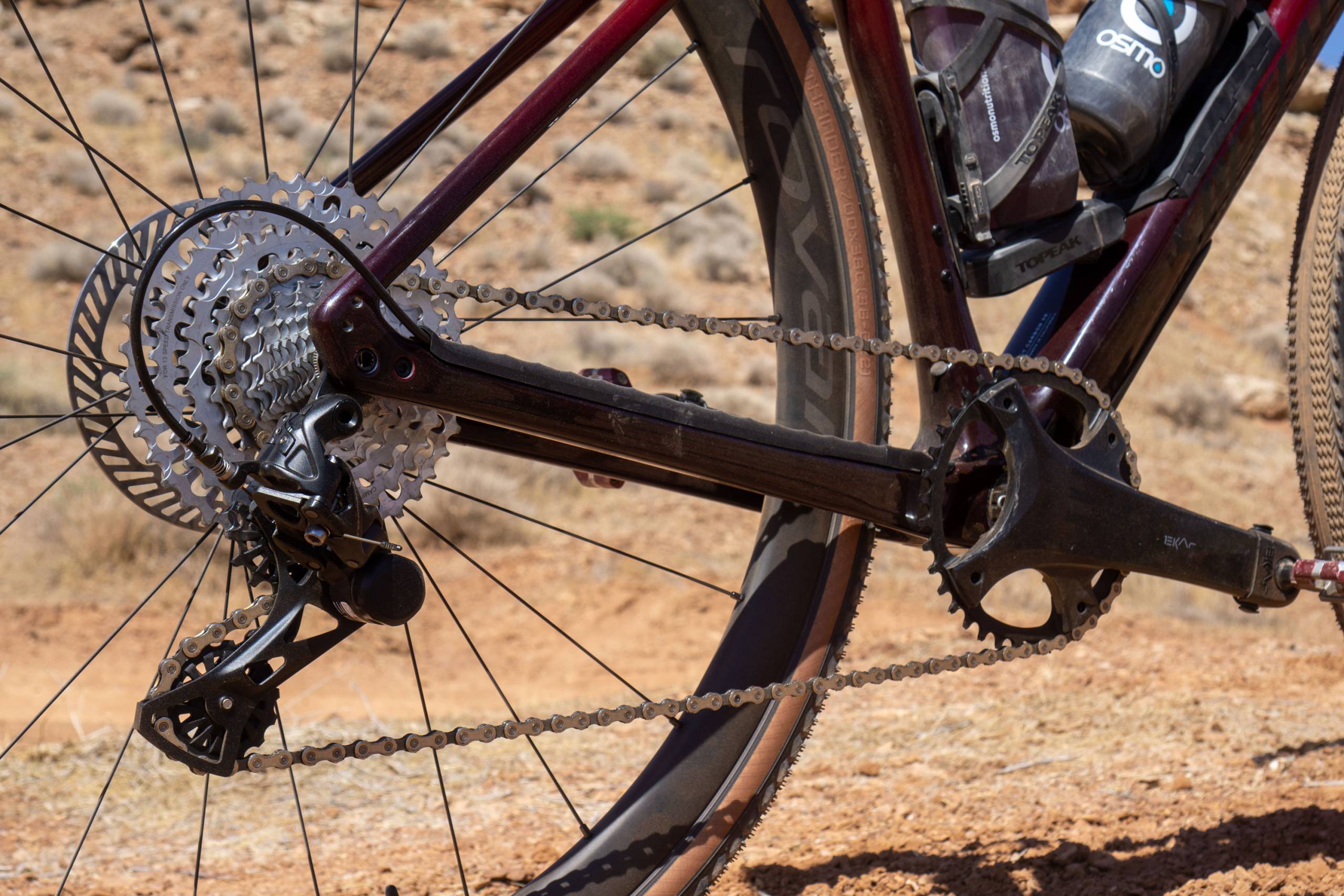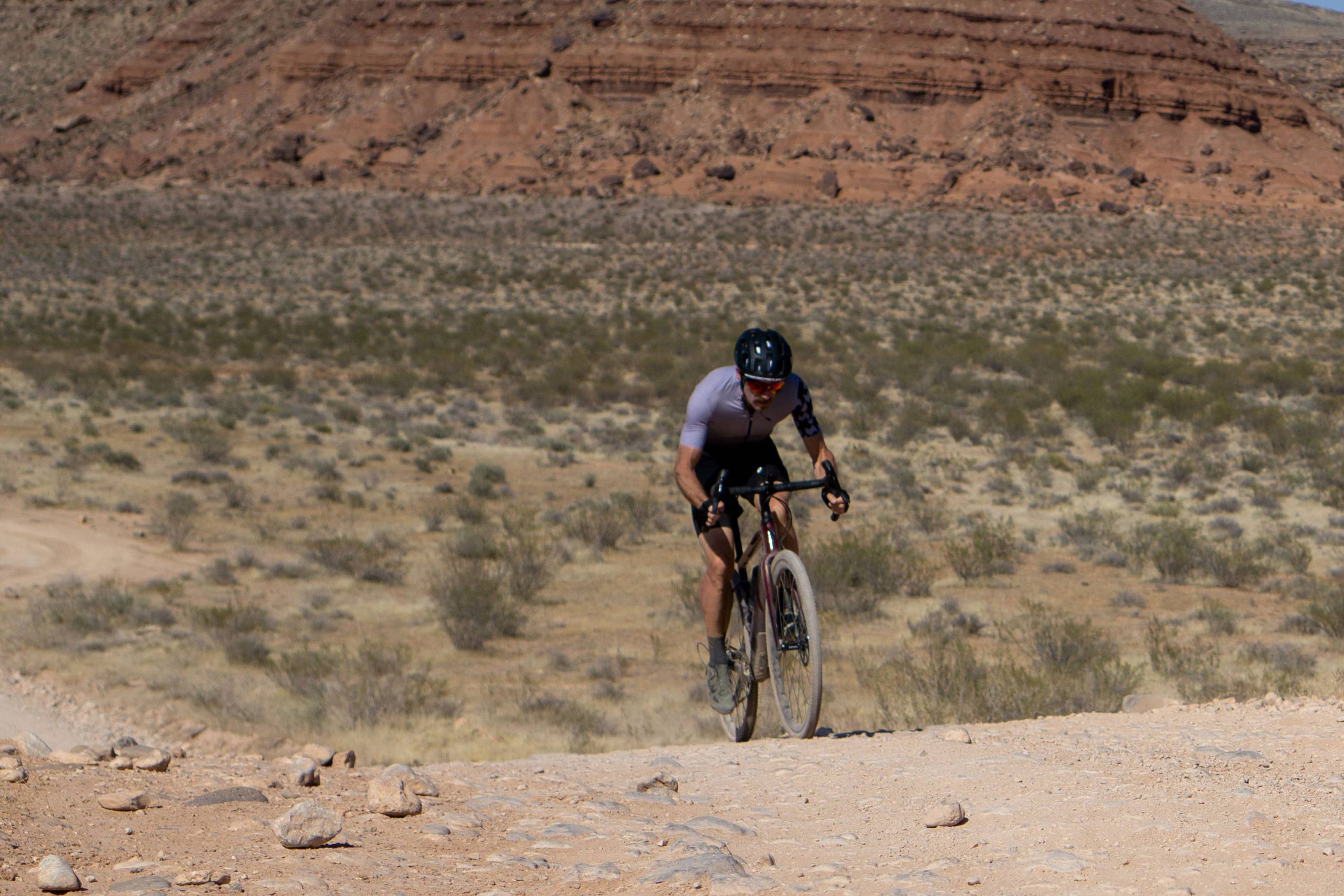Specialized’s Diverge Pro Carbon is an adventure-ready bike, hungry for road, gravel, single track, and more.
Neither road nor mountain, cycling’s gravel category takes the best of both worlds to create a backroad speed monster. You get a lightweight bike with drop bars that churns through the miles, but with the added stability and tire clearance of a mountain bike.
Last month, we spent a week in Utah testing the latest gravel bikes on the market for 2021. We got up early, came home late, and refilled countless water bottles in between. Out of the dust emerged our choice for the best gravel bike.
Specialized’s Diverge Pro Carbon Campagnolo LTD is light, capable, incredibly stable, and a hoot to ride.
In Short: The grandmaster of the bike industry, Specialized has really dialed in how to make a good bike. So, it was no surprise that it produced our choice for this year’s best gravel bike.
With internal storage, wide clearance, a futuristic shock system, and geometry that inspires pedaling off into the sunset (and through the night, and into the next day), the Diverge puts you in a position that inspires big miles.
Specialized offers 12 models of the Diverge gravel bike to meet all price points. The Diverge Pro Carbon Campagnolo LTD ($7,000) sits second from the crown (just below the venerable S-Works). Depending on specs, you can get a Diverge for as low as $1,300 all the way to their $10,000 S-Works model.
Specialized Diverge Pro Carbon
- Frame: Carbon
- Fork: Carbon, Future Shock 2.0 with Damper. 12×100 mm thru-axle,
- Clearance: 700c x 47c / 650b x 2.1″ (*38c)
- Drivetrain: Campagnolo Ekar gravel-specific groupset
- Chain ring: 38T
- Cassette: 9-42t, 13 speed
- Weight (on our scales): 20 lb. 1 oz.
- Price: $7,000 (*Campagnolo LTD); $7,500 (SRAM )
- * tested
Specialized Diverge Pro Carbon Gravel Bike Review
Before we go too far, its important to share that 12 bikes rack the Diverge lineup. Two of them share the Diverge Pro Carbon name: the Diverge Pro Carbon and the Diverge Pro Carbon Campagnolo LTD.
We tested the Diverge Pro Carbon Campagnolo LTD. Unless we share otherwise, we will refer to this bike as the Pro Carbon or simply the “Diverge.”
Outside the Campy groupset and the smokey maroon finish, the Pro Carbon bikes are entirely the same bike. Both have the latest Future Shock 2.0, the SWAT storage, clearance to run 700c or 650b wheels. And let’s not forget a confidence-inspiring geometry that every Diverge bike in the lineup is known for.
More Suspension
Like all of Specialized’s top-tier Diverge models, the Pro Carbon uses the Future Shock 2.0, which is effectively 20 mm of suspension tucked inside the headset. The Future Shock was first developed for the Roubaix to help tackle cobbled roads. Turns out it works pretty well on gravel, too.
The spring coil shock in the 2.0 has a hydraulic damper that feathers the compression and recoil inside the headset instead of the fork. Need more stack? You can add up the 30 mm of stack from the lowest setting with the Future Shock, or use a stem with positive rise to make it feel taller.
The damper is easy to adjust with the dial that replaces the headset cap. Turn it to the right, and it stiffens the ride on climbs. To the left, it unleashes the shock’s 20 mm of travel.
For those coming from the road world, don’t expect massive effects; 20 mm is a far cry from the 120 mm of travel mountain bikers have on their cross-country bike.
The Future Shock looks a little gimmicky — maybe even a bygone component from a mountain bike circa 1990 — but it pairs really well with the Diverge. It’s just enough to quiet the vibrations on chip seal and gravel.
Maybe more important than suspension is tire compatibility and clearance. The Diverge comes trimmed with Specialized’s own proprietary rubber. Our demo came as stock, wrapped with 700 x 38c tires. The frame and fork can accommodate up to 700 x 47c or 650b x 2.1” tires.
With 6 mm of clearance, you can go bolder still, but it will likely affect the collected mud from clearing the stay joints.
All of our bikes arrived tubeless, inflated to upward of 60psi. Entirely too much for any gravel bike. We reduced the tire pressure to the mid-20s, and the 38s were suitable on gravel and road, leaving just enough to negotiate the occasional erratic stone.
More Gears
Power is directed to this Pro Carbon through Campagnolo’s new 1×13 groupset. It’s reputedly the lightest of its kind on the market and the first 1×13 for gravel.
The high- and low-end gears are fairly comparable to other bikes we tested. The Diverge ships stock up with a 38t chainring, which is the smallest ring we tested during gravel week.
The extra ring on the cassette effectively creates smaller leaps between gears. This might best be appreciated on the road, where the lack of rolling resistance (from gravel and steep hills) benefit from being able to fine-tune the gearing.
If we had a gripe, it would likely be with this groupset choice. Thirteen cogs make this the largest cassette to date for a 1x. And it’s a lot of gears to squish inside a single cassette.
As such, we found it a bit finicky in the middle ranges and sometimes struggled to immediately align with the cog. The other Diverge Pro Carbon model is powered by SRAM Eagle, a 1×12 with electronic shifting.
More Storage
Specialized has been taking huge strides in developing better ways to store gear on — and now in — the bike. The Pro Carbon comes with a SWAT door that allows you to stow supplies inside the down tube without compromising the structural integrity of the frame. It’s an ingenious place to stash extra food, your tool kit, a spare tube, or even a wind jacket.
The SWAT door is also where you mount the down tube water bottle cage inside the frame’s triangle. Because bolts go through the door, it’s best to pull the SWAT door wide open when mounting the cage. Otherwise, you run the risk of dropping the bolt stopper inside the frame.
The Diverge has six water bottle mounts, with two inside the triangle and additional mounts on the top tube, down tube, and one on either fork. So, there’s plenty of bosses to kit up for a 400-mile bikepacking race or overnighter.
Ride Tested
Testing multiple bikes, ride after ride, day after day, gives you the ability to quickly assess the true gems from the ordinary. Outside the paint and tires, many bikes are nuanced variations of each other. They often look (and feel) very similar. That is, until we swung our legs over the Diverge.
Easing back into the saddle, we immediately knew that the Diverge would be different. It feels more “mountain-ish” in the saddle. You get a sensation that you are riding inside the bike rather than on it.
Looking at the numbers, the geometry supports this.
Geometry
At the core of any bike is the frame’s geometry. Longer chainstays will feel more “flexy” and stable on longer rides. The length becomes a springboard. A shorter wheelbase will feel stiffer, and hence, nimble and quick.
On the front end, a fork’s offset measures the horizontal distance between the hub and the steering axis. It affects the bike’s “trail,” or the tire’s footprint “trailing” behind the hub’s axis.
A shorter offset means a longer trail, giving the bike more stability. A shorter trail will make the bike quick to turn.
Specialized designed all models of the Diverge with the intent to make the bike more capable and give the rider confidence off-road. But they didn’t want to sacrifice that nimbleness you need for quick maneuvering on the road.
To get there, Specialized lengthened the reach, made the head tube one degree slacker, and increased the fork’s offset by 5 mm. The Pro Carbon had the longest offset — hence shortest trail — of all the bikes we tested. They also lengthened the chainstays a few millimeters.
The length increased the wheelbase, adding some 38 mm on a size 56 frame. The average wheelbase we tested was 1,028 mm in a size medium; the Diverge measured 1,032 mm.
This made the Diverge feel stable and eliminated toe overlap with the front wheel. But we didn’t think it was as nimble as some of the bikes in the test.
The 3T Exploro Max and Open WI.DE. both have a 5mm shorter offset but felt snappier. They forego front suspension and have a shorter reach.
Specialized is notorious for having low bottom brackets and, with an 80mm drop, it was the lowest of the bunch we tested. This round, Specialized raised the bottom bracket’s drop by 5 mm, which allows you to run 650b wheels without clipping pedals in turns. And it still keeps that fantastic stability that makes the Diverge so much fun to ride.
The longer reach allowed the brand to put a shorter stem out front without disrupting the cockpit’s overall length.
How’s this work out in the saddle? The shorter stem paired with the lower trail pulls the turning radius closer in and adds back a touch more nimbleness in tighter turns at speed. This slows the steering effect of larger tires, which we felt made the bike more lively.
On the front end, the handlebars are compact enough to reach the brake levers while in the drops, allowing you to take advantage of multiple handle positions.
The geometry compels tucking into the drops. More than any other bike, we found ourselves tucked in both while climb and descending.
Our test course had a bit of everything: neighborhood pavement, highway, double track, single track, hills to climb, descents to bomb, sand, hard-packed gravel straights, and sandy turns. Our Diverge was sent with 700c x 38mm tires run tubeless. We deflated the tire pressure to 25 lbs. to better handle the rough.
Through it all, the bike felt securely comfortable. But it saved my Lycra-wrapped butt in one particular case.
With one hand gripping the GoPro, the other on the hoods, I was filming my co-tester on another bike while pedaling at roughly 20 mph. Focused on filming, the gravel took a turn and I found myself pinched between a sand-filled rut and encroaching desert scrub. It had all the makings of a WipeOut Wednesday short ride.
Before I knew it, the tire hit the rut, the bike wobbled, I feathered the brakes with one hand, and pulled through the episode with little more than frayed nerves.
“Good save,” I heard from the other side of the double track. But I’d chalk it up to good geometry.
Value
Off the floor, the Pro Carbon we tested will set you back $7,000 ($7,500 if you want to upgrade to the SRAM AXS groupset with electronic shifting).
Outside the groupset, both come equipped with the SWAT storage, the Future Shock 2.0 headset, the 700c/650b clearance up to 47mm, and the phantasmic Specialized geometry. But so do other bikes in the Diverge lineup.
And that’s probably the biggest value of Specialized as a company. They have the means to invest R&D into top-shelf products that trickle down the entire vertical.
The Diverge line has 12 bikes. The higher-end builds (S-Works, Pro, Expert, and Comp Carbon) feature the Future Shock 2.0, SWAT, and variable layups of carbon frames. You can get the Diverge Comp Carbon (with Shimano Ultegra) for $4,200.
The Diverge Comp E5, Sport, and Base Carbon models all use the Future Shock 1.5, a similar 20mm headset shock but sans the hydraulic damper that provides both compression and rebound damping. With an SRAM Apex drivetrain, the Diverge Base Carbon lists for $2,800.
Carbon pricing you out? Specialized has several aluminum models of the Diverge. You don’t buy into the Future Shock system, but you can still swap out 700c with 650b wheels and get that lovely well-balanced Diverge geometry.
Bringing up the tail of the lineup, the Diverge Base E5 can be had for $1,300, which we feel is an incredible value.
If money was no object, and we had to choose between the Diverge Pro Carbon and the Pro Carbon Campagnolo, we’d pay the extra $500 for the Pro Carbon with SRAM. What the cassette loses in one gear, it gets back with consistency. Electronic shifting is really that good.
Who’s the Diverge For?
Sitting between road and mountain, gravel bikes cover a wide range of territory. Designers tweak the geometry to move bikes toward one end or another.
On one side is the cyclocross ride. It’s stiffer, lighter, and quicker handling for high-speed cornering. On the other end, mountain-like adventure bikes have more clearance for fatter tires and a longer wheelbase for comfort.
The bottom bracket is lower and the head tube is long and has a more relaxed angle. This all equates to more stability and comfort in the saddle.
To help make sense of it all, we rode every bike tested during gravel week on the same course. Then we put every bike on a scale, ranking bikes from 1 to 4. One indicates a bike is best suited for tamer gravel and speed, with 4 being more capable of negotiating rocky, rooted trails.
We slotted the Pro Carbon as a 3. For scale, Kona’s Libre’s gnar-friendly geometry and dropper post tipped the Libre up to a 4. It rode like a rigid mountain bike with drops. The Alchemy, a racy-oriented thoroughbred, was more appropriately a 2.
The longish wheelbase and the lowest bottom bracket of the bunch, the Diverge is the most stable bike we tested, which makes it perfect for long rides down drawn-out gravel roads.
And the 20 mm of travel in the fork is just enough to hush the hand-numbing chatter, but not so much to negotiate rough single track.
The Diverge’s geometry pushes your weight further forward, and the stem is longer, too. This balances your weight between the butt, feet, and hands, allowing you to go farther more comfortably.
While the geometry and 20 mm of travel are what makes the Diverge a standout, it takes away from its ability to race tight-cornered courses on the road. It had the shortest trail we tested during gravel bike, but we there were other bikes that felt more nimble (the 3T Exploro Max, Open WI.DE, or Alchemy are more “racy”).
Can it race? Sure. But it’s best suited for ultradistance bikepacking races where you get the comfort, but don’t need that responsive handling.
Specialized Diverge Pro Carbon
Pros:
• Future Shock 2.0 (giving the bike 20 mm of suspension)
• SWAT internal storage
• 700mm or 650b wheels
• Well-balanced geometry puts you “in” the bike
• Reach and slack is exceptionally comfortable
• 12 models in the Diverge lineup to choose from
Cons:
• For the price of the Pro Carbon, we’d expect electronic shifting. You’ll have to pay $500 to upgrade to the Pro Carbon.
• “In the saddle” geometry may not suit riders who want pure speed.
• Its 13-cog cassette didn’t shift as cleanly as less compact 11-cog cassettes.


















